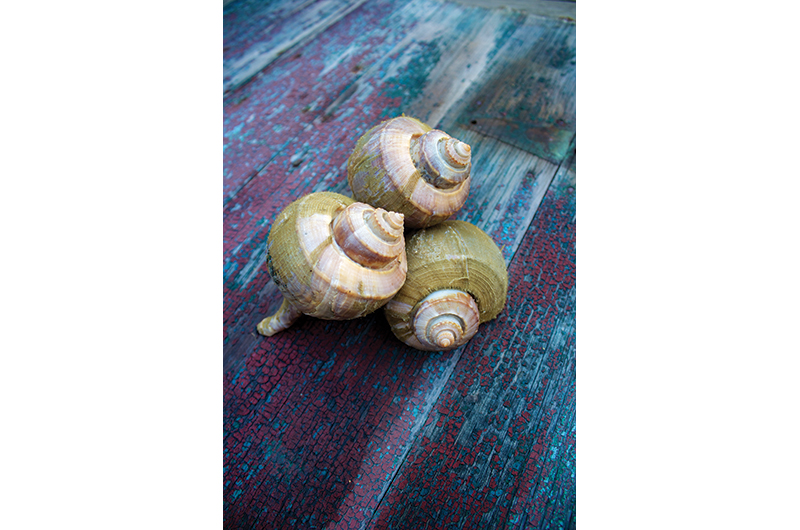Over the years, like many a casual beachcomber, I’ve picked up a few conch shells, each one a pear-shaped whorl topped by a spire, like a coil pulled from the center. The shell interior is polished brick-brown, narrowing to a slender aperture. The exterior is greenish tan, with translucent, burlap-like patches, but when sun-bleached the shell is a charming addition to other native shells that adorn our kitchen windowsill. Among seaweed piles I’ve also found conch egg casings – often called mermaid’s necklaces – parchment-like disks spiraled along a string, often a foot long. When dried and shaken, they make a musical rattle. A hole in each disk allows the baby conchs to hatch, and a close examination of a full disk reveals twenty to thirty minuscule conchs inside.
On the Vineyard, conch has become reliable income for a couple of dozen fishermen as the fishing industry undergoes profound changes. Regulations and quotas on fish from tuna to flounder to herring are now a fact of life, with the diverse marine community determined to achieve sustainability. Lobster, once a solid income source for Island fishermen, has become scarce: An estimated 30 percent of lobsters south of Maine have contracted a bacterial shell disease thought to be caused by plastics and industrial ocean pollutants; though it does not taint the meat, it causes unsightly black spots and pitting. With fishing options narrowed, conch has steadily gained marketability. It’s now a prime Island export.
Conch fishing in New England is, more accurately, fishing for whelk – the correct name for the gastropods, but one not used by fishermen or distributors. Yet Nantucket Sound conch is only distantly related to the tropical queen conch, Lobatus gigas, nestled in turquoise waters, whose shell sports a sexy ruffled lip and who wears a crown magnificent as a white-spired castle. Caribbean cultures venerate her delicate meat, as well as the coveted pink pearls that one in every ten thousand produces. She is such a symbol of pride that West Indian people sometimes put her in the yard to announce the birth of a new child. Tourists stuff her into suitcases to cart home – illegally, for she is endangered and protected internationally. Key West natives of all races dub themselves “conchs” in honor of the Bahamians who immigrated to the Florida Keys beginning in the eighteenth century.
The term conchologist denotes those scientists and amateurs who study mollusks, distinguishing them from shell collectors. With more than sixty conch species, many different cultures and the arts boast a wealth of uses, from musical horns in ancient Peru to the sacred Buddhist and Hindu shells of Tibet and India. Hawaiians call the conch trumpet a pu, blowing it to open the state legislature and to present the royal court at a hula festival.
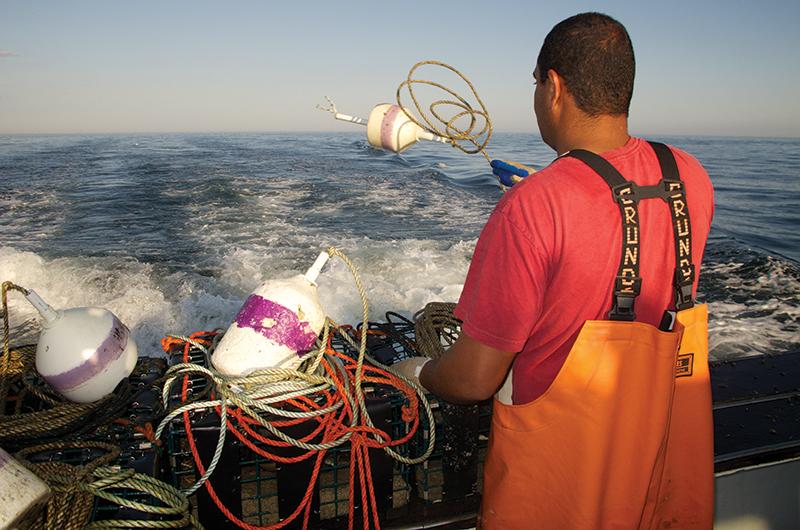
In the early morning, Graciano Rocha of Vineyard Haven checks and sets traps for conch in waters about nine miles northeast of the Vineyard.
Rebecca Busselle
But along the northeast coast, no one seems to pay much attention to conch.
The indigenous Wampanoag once made sacred wampum beads not only from clamshells but also from conch, and today a few Wampanoag artisans still use conch to make jewelry. Gastronomically, I’d come across Manhattan conch chowder in my great-aunt Irma Rombauer’s Joy of Cooking, but never made it, and I’d heard of, but never tasted, the Italian delicacy scungilli. Such was my ignorance of the multi-million-dollar industry that was helpingthe Vineyard’s small-boat-owner–operated fishing industry to stay afloat.
Going Fishing
In Edgartown harbor one October morning, Donnie Benefit’s boat, Payback, is set to depart at 5 a.m. In the chill air, Donnie has hiked his jacket hood up to protect his ears, but his crew-cut hair is uncovered, as are his hands. Working in the dim light from Payback’s cabin, he methodically stuffs black mesh bags with his preferred conch bait. He plucks imported frozen Maryland blue crab from bushel baskets, herring and cut-up horseshoe crabs and bunker (menhaden, a kind of herring) from ice-filled tubs. It seems exceedingly cold for this barehanded work – which he seems to mind not at all. Island born and raised, he is the third generation to fish for a living.
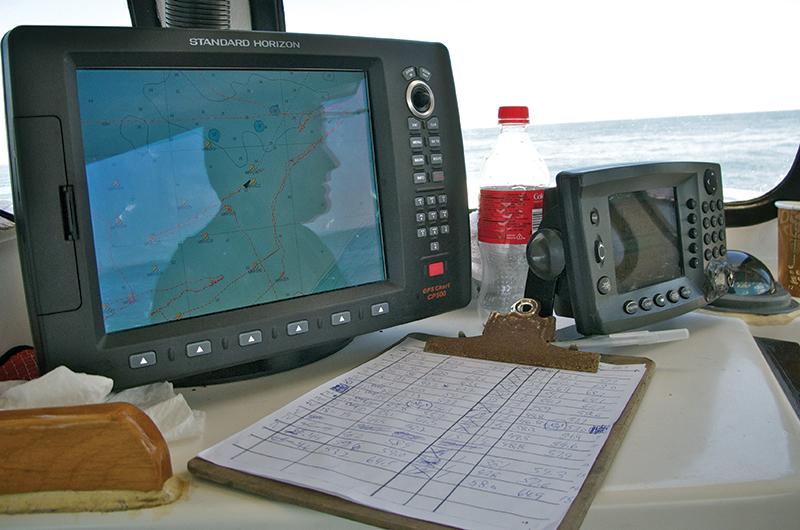
Technology such as GPS (and an old-fashioned clipboard) help fishermen track their conch pots.
Rebecca Busselle
Helping load bait bags is his mate, Brazilian-born Graciano Rocha, a man Donnie values and respects. With a painful arthritic hip, Donnie would have a hard time managing without the help of Graciano, whom he calls “my machine.” During the day, the two of them will haul, dump, rebait, and reset dozens of conch pots.
When they finish loading and stowing bait, Donnie pulls a pair of Hercules waterproof bib pants over his jeans to prepare for the long, wet morning. He moves into Payback’s cabin to head out in dark, rough seas. With the bow of the thirty-six-foot boat plowing though waves, spray smashing against the windshield, he cranks up the radio and pours coffee from his thermos, steady as a juggler, without spilling a drop.
During the forty-five minutes of travel to the fishing grounds, Graciano retreats to the cabin for a nap, as though the pitching boat were a cradle and the engine roar a white noise. We slam toward Horseshoe Shoal, where yesterday Donnie laid his strings of pots.
Channeled whelk, Busycon canaliculatum, makes up the bulk of most Vineyard catches, and knobbed whelk, Busycon carica, though more rare, also comes up in pots. While Caribbean queen conchs are herbivores, channeled whelks are carnivorous, with a taste for carrion.
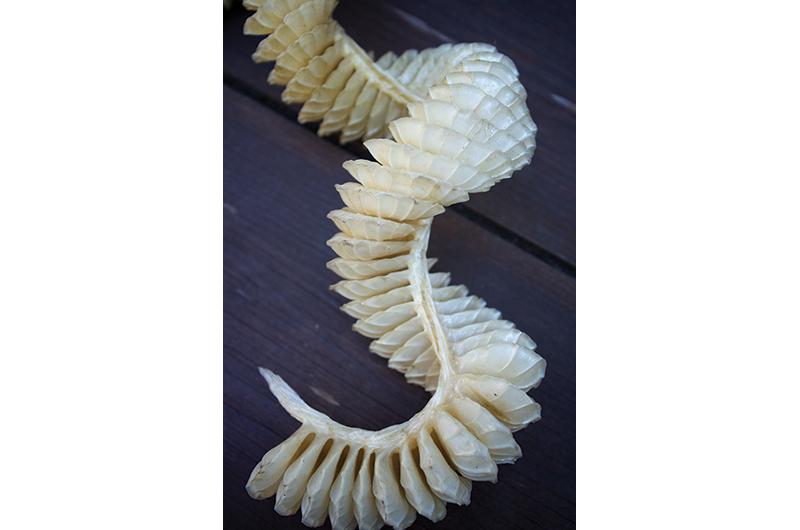
Parchment-like cases hold hundreds of conch eggs.
Rebecca Busselle
Moving along sandy shallows, they feed on mussels, lobster, clams, crabs – all the ingredients that make Donnie Benefit’s bait meal tantalizing (or so he hopes). Horseshoe crabs have long been the traditional preferred fishing bait.
According to fishing lore, centuries ago a Wampanoag speared a horseshoe crab (once so plentiful that they buried them to fertilize the soil) and left it overnight at the tide line, returning the next morning to find it covered with conchs. In the past few years, however, many environmentalists and fishermen have become concerned by the decline in horseshoe crabs, one of the oldest species on the earth. Not only do conch and eel fishermen rely on horseshoe crabs, the biomedical industry does as well. Mixed-bait bags, such as those Donnie straps into the bottom of his pots, trap conchs more responsibly, using at least 50 percent fewer horseshoe crabs than traditional methods.
Conchs (the name under which whelks are caught and sold) move as snails do, powering over sand and mud flats in relatively shallow waters, propelled by a strong foot that ends in an operculum – a tough, oval toenail-like covering for its shell opening. When a conch finds a potential bivalve meal, it opens the shell with its operculum and, using a rasp-like proboscis, extracts and eats the soft, nutritious tissue.
Fertile Horseshoe Shoal
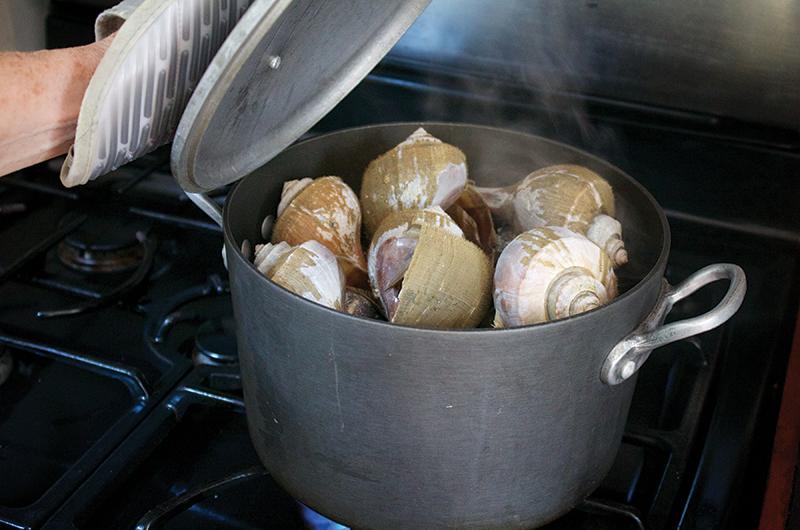
Because of the odor, steaming conch is best done outdoors or in a well-ventilated kitchen.
Rebecca Busselle
Dawn sneaks up on us, painting blush on the horizon as we head over open water toward the Horseshoe Shoal fishing grounds. The vastness is broken by the looming 197-foot meteorological tower, with an FAA warning light atop it, marking the area where the developer Cape Wind plans to erect 130 vertical-axis turbines, each more than 400 feet tall. In these shallow waters lie the most fertile conch grounds. The Vineyard fishing community remains deeply opposed to the placement of turbines in this twenty-five-square-mile area, citing not only environmental marine degradation, but foreseeing navigational rules and outright territorial bans that they fear will put an end to small-scale fishing and a way of life that helps define the Vineyard.
The Wampanoag Tribe also remains opposed, not only decrying the despoliation of their ancient lands and probable burial grounds (most agree that shallow Horseshoe Shoal was once dry land) but also the ruin of the culturally important sunrise vista. And the sunrise is indeed glorious.
Payback slows and idles, at the mercy of the waves, with no forward motion. We’re here, at the first pot. Graciano leans down and deftly grabs the buoy. With an energy that pivots from anticipation to anxiety, Donnie throws the line over a sturdy davit to haul the pot, and when it breaks water he pulls hard to swing it onto the gunnels, the sea pouring through the barnacle-encrusted trap. And the pot – a little larger than a milk crate with a lip on top to keep conchs from crawling back out – is full. With relief, Donnie holds up a big one and grins.
Both men begin to sort, swiftly throwing back debris and ones that don’t meet the minimum size regulation, and tossing mature conchs into a bag-lined red barrel. Graciano moves the pot – empty except for its forty-five- to fifty-pound weight – to the stern, coiling the line and readying the buoy to be thrown later into new fishing ground. In the cabin Donnie pulls back the throttle, turns up the rock-and-roll, and, slamming down on the waves, speeds to the next pot. And the next, and the next, while the sun climbs, a silvery ball high in the sky.
Sometime after noon, with plump conchs filling more than a dozen large bags that each weigh about eighty pounds, Donnie and Graciano head back from Horseshoe Shoal. Even in mid-October conch is abundant. Louis Larsen, a third-generation fisherman and owner of the popular Net Result fish market in Vineyard Haven, says that conch fishing continues “until the first snowflake, then they disappear.” Conchs will retreat into deeper waters and burrow into mud, reappearing in mid-May and spawning along their route back to the shallows.
The Wholesale Market
As Payback ties up to the Edgartown dock, Danny Chan backs up his refrigerated box truck. As a conch broker, Danny spends the fishing season in Vineyard Haven, working from his Aqua World conch-sorting facility on Lagoon Pond Road. The plant – a cinder block building with a loading dock – is so low-key and unassuming that few Vineyarders know what it is. Aqua World acquires the bait fishermen request, delivering it before the boats head out, and meets them to receive the catch when they return.
Now Danny Chan will help Donnie and Graciano unload, swinging the heavy bags onto the dock and lifting them into the back end of his truck. When three fishing boats have come in with their hauls, 2,500 to 3,000 pounds of conch will fill the truck. In an industry with unregulated limits, catch is determined by a fisherman’s stamina – plus luck and know-how.
Like many immigrants, Hong Kong–born Danny Chan came to the United States to study. The road to education is paved with hard work, and thanks to his brother-in-law, by the time he was sixteen he was shucking conch in New York’s Chinatown (a better job than packing scup, which could pay as little as $60 for a full night’s work). He worked his way through college and took graduate courses in electrical engineering. And kept his hand in the conch business. His first deal brought him 35 cents per pound.
Danny and an assistant return to the sorting facility, where the building is eerily quiet. The men haul bags from the truck to a rolling scale and weigh each one before sorting. The stainless steel sorting tray looks like a prone body with Y-shaped legs; the tile floor has been scrubbed as clean as an operating room. The men heave an eighty-pound sack onto the long tray torso, then uplift the bag, emptying the sack with a thunderous, shell-hitting-metal din. This will continue ceaselessly for more than an hour as Danny and his helper empty sacks and sort the largest – called “selects” – from ordinary conchs, channeling them down the sorting legs into more sacks.
Heavy rubber gloves protect their hands from the sharp edges as they shove shells down the tray, but the work is grueling. As they’re pushed along, conchs and barnacles screech against sand, like fingernails against a blackboard. The deafening noise reverberates through the room. Danny Chan says that workers usually last one season. “After that, if any other job comes along – like painting – they jump on it.”
With the conchs sorted, bagged, and reloaded, and the refrigerated truck filled, Danny is ready to drive the catch to another plain, nondescript warehouse – this one in Brooklyn – for distribution.
From Sea to Plate
In Asia and Europe, conch is much in demand; those markets are developed and mature. With queen conch listed by the Convention on International Trade in Endangered Species (CITES), channeled whelk suppliers from the United States have competed to fill a need. China’s population – with more than 600 million in urban areas – loves conch. The Beijing Ritz-Carlton hotel featured a soup of conch and matsutake mushrooms as part of its 2011 Lunar New Year feast, and tiny food stalls stir-fry them with tofu. Japanese eat them as sashimi; the French call them bulots, dipping them in garlic mayonnaise; Malaysians in Kuala Lumpur eat them curried; and the British like them boiled and served with a splash of malt vinegar. Global desire has saved small-boat fishing industries such as the Vineyard’s, but has brought its own environmental hazards, as huge conch trawlers ply the Atlantic coast from Argentina to Nova Scotia. Overfishing is a constant concern.
Domestic sales of fresh and frozen conch to restaurants and stores account for about 30 percent of Danny Chan’s distribution. Americans have a squeamish attitude toward eating snails, both sea and land, including escargot, the most popular food snail in the world. The West Coast has no culinary conch: California stringently regulates abalone, a sea snail delicacy, allowing shore pickers or free divers (not scuba) three per day and twenty-four per year. Oregon’s regulations are stiffer, and Washington state prohibits abalone gathering. No wonder West Coast gastronomes treasure Nantucket Sound conch.
Of the ethnic markets in the US, probably the best known is for Italian scungilli, an important part of the traditional Christmas-time Feast of the Seven Fishes, as well as an anytime favorite. Since cleaning and preparing conch takes work, frozen and canned conch have lightened the load for the cook. An Italian neighborhood on Staten Island boasts scungilli-topped pizza, and restaurants from New York to Boston feature scungilli salad. But Italians are not the only conch lovers: from the Haitian dish lambi in Florida to the huge Asian superstores in Midwest strip malls, there are outlets for conch throughout America.
On the Vineyard, conch is nearly invisible on the seafood menu. The Martha’s Vineyard Cookbook, by Louise Tate King and Jean Stewart Wexler, opens the shellfish chapter with a quote from maritime musicologist and historian E. Gale Huntington. He enumerates the abundant shellfish that early Island settlers and indigenous Indians ate, including “the big whelks which Vineyarders called winkles.” Nowadays few people could tell a winkle from a wink. Even that venerable cookbook has no conch or whelk or winkle recipe, Vineyard restaurants rarely offer conch, and it only sporadically appears in fish markets. Those who eat it either rely on fishermen who find it as by-catch invading their lobster pots, or go after it themselves.
Back home in our Vineyard Haven kitchen, my system recovered from a day pitching and yawing in Payback, I began to think about turning the eight plump conchs that Danny and Donnie bestowed upon me into something delicious. Everyone I’d talked to agreed that if not properly prepared, conch is rubbery. As with squid, minimal processing or heavy cooking yields tenderness, but the muscle toughens during the in-between stages. Donnie suggested stuffed conch, which he approaches with a two-hour steaming. Each summer Donnie and his family host a seafood extravaganza for which he stuffs and roasts 125 conchs. “And five minutes after we put them out, the platter is empty,” he reports.
But this day my husband and I were alone, with no crowd in sight. I turned to my primary resource, Joy of Cooking, the book on which I (and so many others) grew up. I wanted a more exotic recipe than Manhattan clam-turned-conch chowder, a tribute to the global love of conch. In the 1997 Joy of Cooking edition, I found a recipe for clam, squid, or whelk fritters – a staple of Caribbean cultures – but with a twist I can tie to Aunt Irma’s German-American heritage: A bottle of beer leavens the fritters.
Using Donnie’s steaming method, I began the two-hour process, nearly meeting disaster when I lost track of time and let the water boil dangerously low. When the conch had cooked and cooled, I began to prep them. I used my fingers, but as Aunt Irma promised, the conchs roll easily out of the shell with a fork. I sliced off the horny foot – the operculum – then separated the meat and discarded the soft gut. I cut the conch in half crosswise to expose the internal digestive tract, which I removed with my fingers, then rinsed it under running water. I was ready to make the fritters.
By the time I’d finished cooking, lunch hour was late. I found a jar of chutney in the fridge and put it on the table along with a bottle of hot chili sauce for my husband Sam’s spice-loving palate. We approached the golden, brown-edged fritters with some awe, aware of the conch’s full journey from ocean bottom to Payback to sorter to kitchen. Plus we had detoured these conchs away from Brooklyn and possibly Asia. Beer batter makes a delicate and delicious fritter. We devoured them. Cooked up another round. And still had batter left over.
So I sautéed the rest, put them on a paper plate with a dab of chutney, covered the plate, and ran them up to Mike Carroll and friends, the crew making repairs on a neighbor’s house. They had just finished their sandwiches, but couldn’t refuse these Vineyard delicacies. Not only did they eat heartily, but someone had a story to tell about finding a trove of beached conchs after a storm. And carpenter Fred Hall dictated a family recipe for marinated conch that he had learned from his father and makes each summer from conchs that his son gathers.
Whether you call them winkles or whelks or conchs, they’re a thriving industry and a tasty meal for the adventurous.
Finding Conch On-Island
Although conch arrives on Vineyard docks by the ton, tracking it down for retail purchase here requires a little effort. A restaurant search found it on only one menu, at Deon’s Restaurant on Circuit Avenue in Oak Bluffs. Chef/owner Deon Thomas, who hails from Anguilla, has customers “who could gladly slit my throat when I don’t have conch.” By freezing fresh local conch, he’s able to clean it of the dark skin that covers the foot, which makes it visually indistinguishable from Caribbean conch. The flavor is milder, plus it’s easier to work with and more tender. His pumpkin and vegetable conch soup is a constant sellout, but buying conch when the price is high, as it has been in recent seasons, is problematic.
At the Living Local Harvest Festival at the West Tisbury Agricultural Hall in October, chef Kevin Crowell of Edgartown’s Détente and chef Bill Manson demonstrated conch’s fine-dining potential with conch Milanese. They added crunch with a panko coating over conch that had been tenderized by brief cooking and a soak in pulverized kiwi, which contains softening enzymes well known in Bill’s native New Zealand. Garnished with thinly sliced Morning Glory Farm radishes and Aquinnah sea beans, this sophisticated dish was a feast for the eyes and the palate.
Although no seafood stores on-Island regularly stock conch, we found several that will order it for home cooks:
- Edgartown Meat & Fish Market owner Sean Ready says he special-orders both Caribbean conch and local conch. 240 Edgartown–Vineyard Haven Road at the Triangle, Edgartown, 508-627-6200, edgartownmeatandfish.com.
- Edgartown Seafood occasionally stocks it and gets local conch upon request. Owner Dan Larsen says, “There’s not a huge market for it here on the Island, but we’ll get it for anyone who calls and asks for it. We go down to the dock and get it from one of the boats.” It costs about $2.50 for one conch. 138 Cooke Street, Edgartown, 508-627-3791, edgartownseafood.com.
- The Net Result can order (for the ambitious conch cook) seven-pound bags of frozen meat from northern conch harvested in coastal waters from New Jersey to Maine. The frozen meat retails for $8.50 to $10 a pound. 79 Beach Road at Tisbury Marketplace, Vineyard Haven, 508-693-6071, mvseafood.com.

